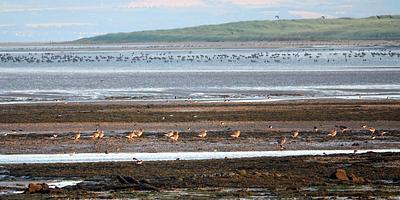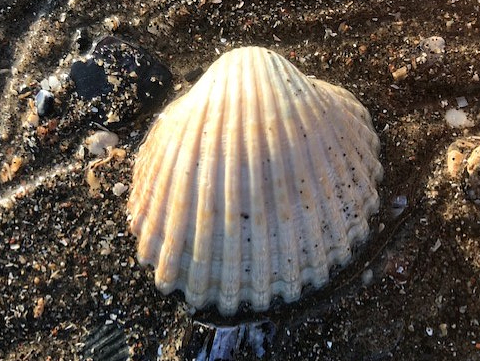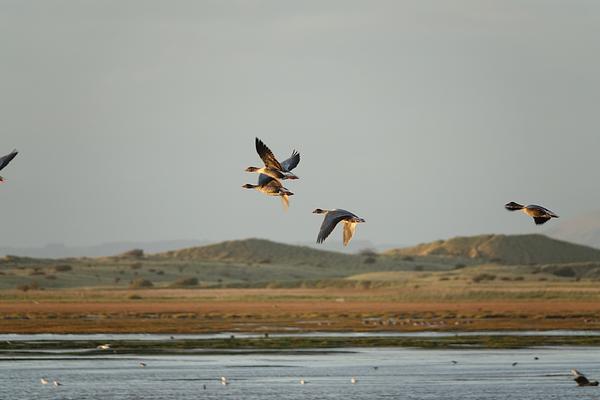
MUD FLATS
Mud flats are intertidal habitats, switching twice a day from a sea-covered environment to one exposed to air, sun, wind and rain.
Mud flats are incredibly important habitats - they act as natural flood defences, birdwatching hotspots, and their nutrient-rich sediments support a great abundance of life.
The most ecologically important sites are designated as Special Areas of Conservation, sites that are strictly protected sites under European law.
FORMATION
Mudflats occur in sheltered bays and estuaries where water flow is slow enough for fine sediments carried by the tide and rivers to be deposited in layers of thick, sticky mud.
As the mud builds, nutrients are trapped in the layers, leading to energy-rich deposits able to support an extensive food web.
INHABITANTS
Life within mudflats is dominated by invertebrates (animals without a backbone) such as mud-shrimps (Corophium volutator), mud snails (Hydrobia spp.), common cockle (Cerastoderma edule), and species of lugworm and ragworm.
A lack of saltwater is a stressful thing for a marine creature, so species that exist here have developed interesting behaviours and body parts to help them cope when the tide goes out.
Most animals live within the mud to prevent them from drying out. This is particularly true for the soft-bodied species without shells, suh as species of worm; lugworms (most commonly Arenicola marinas - also found on sandy shores) live 'U-shaped' burrows, whereas ragworms wriggle through the mud in search of prey.
Cockles are 'bivalves', meaning they can seal themselves inside two halves of a shell. They can also bury themselves in the sediment, using their powerful foot to dig their way through the mud. Cockles can even use their foot to jump across the surface if they accidentally get excavated!

Invertebrates of mudflats have a variety of feeding methods:
- Lugworms and certain species of snail are detritovores that feed directly on the nutrients surrounding mud particles.
- Other snails are herbivores and graze on algae.
- Cockles are 'filter feeders', using feeding tubes called siphons to filter out organic matter from the water.
- Ragworms are carnivorous worms that prey on anything they can get their powerful jaws on. A species of ragworm called the king ragworm (Alitta virens) can grow to 3 feet long and even give us a nasty nip!
Birds
Mudlfats are globally recognised as important habitats for birds. Invertebrates occur in such high abundances that they provide a bounty of food for millions of waders and wildfowl such as the curlew (Numenius arquata), oyster catcher (Haematopus ostralegus), knot (Calidris canuta) and dunlin (Calidris alpina) all year round.
Migratory birds, including species of geese (e.g. the brent goose, Branta bernicula) and duck species (e.g. teal, Anas crecca) also take advantage of the feast and use mud flats as refuelling sites on their long migrations.

Pink-footed geese (Anser brachyrhynchus) travel from Iceland to overwinter in the UK. Montrose Basin in Angus, Scotland, plays host to huge autumn gatherings of pink-footed geese through October and November. A record breaking 85,632 individuals were counted there in October 2015; one quarter of the UK's wintering population at the time.
Birds that feed on prey within the mud have evolved different sized and shaped bills for different uses; the dunlin has a small beak for picking small prey from the surface; the curlew has a long curled bill designed for probing for worms buried deeper in the mud; whilst the shelduck (Tadorna tadorna) has a shovel-like beak used for sifting through the mud for small shellfish and snails closer to the surface.
LOCALISED THREATS
In addition to the large-scale threats facing the marine environment, mud flats are at risk from the following:
- Coastal development
- Human pollution - agricultural and urban runoff add nutrients and chemicals to the environment
- Disturbance - bait digging and mooring boats in estuaries can disturb birds and damage the habitat
